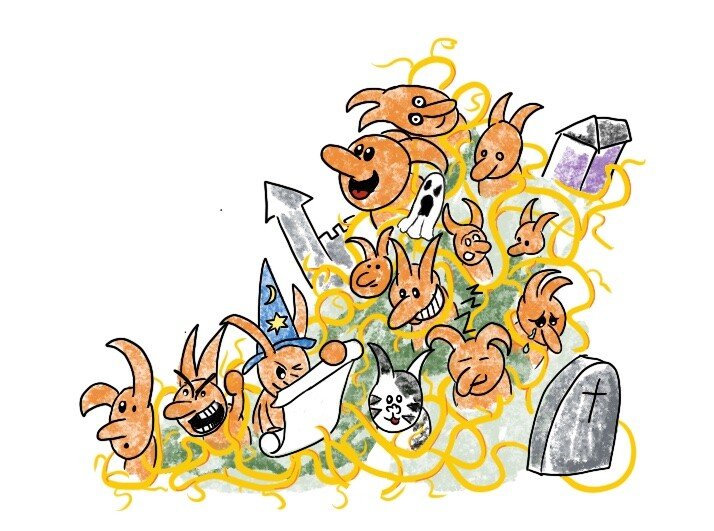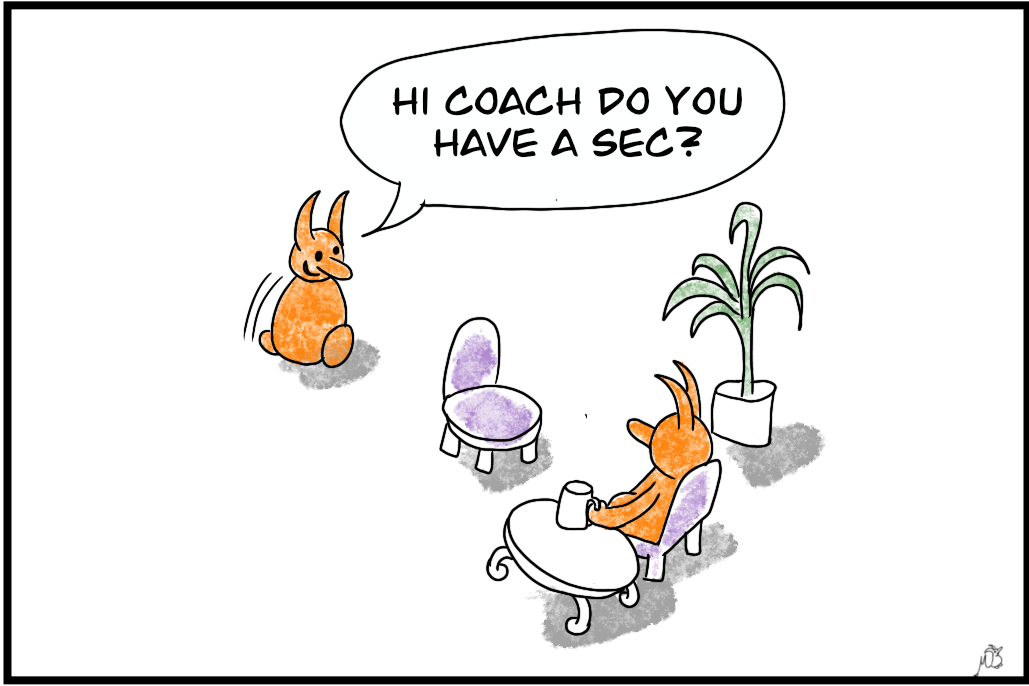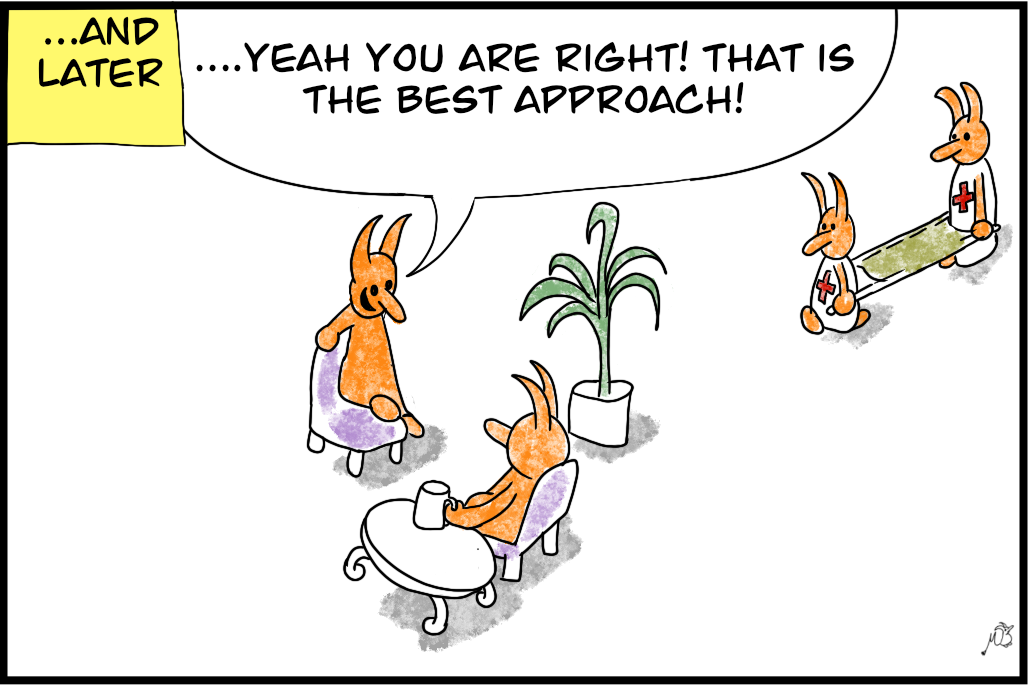Realizing you have silos is the first step to doing something about it. The next step is hard work, so bring a friend 🙂🤜🤛🙂
Monolithic Value stream
A while ago, I first attempted illustrating a value stream in a Vige Crowd context; since then, many things have been going on, but this has always been on my mind. Expect more things to come in this area soon. But in the meantime, I have a new illustration for you. This time, I'm after the feeling a team has when caught up in a monolithic code that has grown so big that it requires several teams, but at the same time, people are stepping on each other's toes to get anything out.
So lets see what we have, first the teams…
…and now the monolith…
… and finally the customer.
Here is the full picture.
Multicultural teams and psychological safety
I meet many teams in my work, often multicultural in their setup. This is a great asset that can help teams to add multiple perspectives and be stronger as a team. But it is also a hindrance for team development. The more different we are the harder it is to reach #psychological safety, align towards a shared team purpose, agree on rules, way of working, take decisions etc. All needed in a high performing team. So in other words multicultural teams have greater potential but also some extra steps that are important to be aware of. How we interact and what assumptions we have on each other is habitually formed by the culture we come from, most of us are unaware of this. We feel that what I do is the normal/obvious way, and when we meet people from other cultures we tend to think that their behaviour is strange and wrong. This is of course also connected to our set of self-serving biases that serve to explain away our own actions in a way that props up our self-esteem. This hindrance for a team can be hard to break through and could block teams from developing into high performance. Awareness is the first step.
In my work as Team Coach I follow teams from the outside, coaching them and the Team Leads / Scrum Master, or whoever has the main responsibilities to enable team development. I often make use of a tool called GDQ, developed by Susan Wheelan, with 60+ self assessment questions that helps to identify in what stage of team development the team is in. In one company that I work with, all teams are free to sign up for a GDQ and then also to repeat the GDQ once every six months to better support and help them in their journey. One of these teams did recently run their second GDQ, the result showing some early signs of entering Stage 2 (Fight and countertendency) but also strong indication that they still were in Stage 1 (Dependency and Inclusion). In 8 months a team should have been able to move further in the team development, we needed to investigate this further to give better support. In the report we saw indications of silence, lack of involvement and decision making were important areas to focus on. After discussing the result with the team and then also in a 1 on 1 session with the Scrum Master we decided to dive into the cultural aspects of these areas. We devised a WS consisting of three parts, cultural differences, personal preferences and analysis.
Cultural differences
I invited all team members to consider the following question: "In the culture that I come from, how do we look at engagement and decision-making. How do we enable it and how does it look like", using an adapted 1-2-4-All pattern we created a list of all cultures (7 nations in a 11 person big team). Each nationality shared their different perspectives, we then reviewed the similarities and differences. We also discussed what we liked with the different cultures and what we did not like. Some members in the team emphasised that even though some things were part of their culture he/she did not like, follow or felt detached from it in some way. I had anticipated that and that is why we also stringed in another part, their personal preferences.
Personal preferences
To continue our investigation and collective learning we continued into the personal preferences. In this session I made use of the exercise "my washing instructions" in which each team member writes down answers to the following statements "what brings you energy", "how to best communicate with me", "what makes me frustrated", "what people misunderstand about me.". This is then shared with an other person in the team, she/he listens actively, notes things down and prepares to share his/her understanding of this person with the others in the team. We ended the session with some reflections on what we have heard, what is common, what stood out as important and what we need to take into consideration.
Analysis and actions
So now we have helped to bring forward a lot of information to the team, both helping each other to see what cultures we have in our habitual behaviours but also how we are unique. I like to use the liberating structure What, So What, Now What to make sure that we first list the facts that stand out, analyse the facts to see if there are any hypotheses that we can form and then based on that device actions. This to avoid jumping directly into faulty assumptions and actions, if you have not tried it i encourage you to do so you will be surprised on what will happen when we combine our brains in these steps.
I'm sure that this session helped the team to take the next step in team development, to make their own team culture, to be more aware of the cultural habits and most of all the personal needs and traits so that they can make use of it when they continue their journey. I hope that this short post encourages you to try something similar. Below I have added my script for the session.
| Time | Agenda | Why | How |
|---|---|---|---|
| 13:05 | Introduce WS | Culture enables strategy → effective decision making | Reflect back to team development and where we are right now. Introduce that today we will dig into the topic of Involvement and Decision making Focus on "Involvement and Decision making" Multiple perspectives: Cultural, Personal |
| 13:10 | Cultural differences in involvement and decision making | To get a better understanding on where people come from. | 2 min - Invite everyone to think for themselves on this question: "How do we in the culture I come from involve and take part in decision making?"
Do you have any examples that illustrates this, (in a fun way if you want)
7 min - For those that are more than one from their own country share and discuss what to share. For the others continue to refine what to share. 20 min - Share with the whole team 5 min - Reflect on differences |
| 13:50 | Break | To get some time to rest and reflect | |
| 14:00 | Personal needs | To get a better understanding on our uniqueness | 2 min - Introduce the concept of washing instructions and how that can be used as a fun way to explain who you are and what is important for you as an individual in the team.
10 min - Now invite all participants to write their own instructions. Encourage creativity, if they want to add pictures or draw something this is mostly welcome. 5-10 min - In pairs Group the team into pairs and invite everyone to share their instructions to the other person. Inform them that they will need to share the other person's instructions. 1 min per person - In the whole group - Ask each person to share other persons' do's and don'ts. Ask everyone to observe the individual needs, the things that stand out and also those things that you have in common. When everyone has shared another person's washing instructions ask the question. "What do we have in common?" Also "Are there some things that we need to adapt to, some specific needs that mean we need to change some things we do?" |
| 14:55 | Break | ||
| 15:05 | Actions | What, so what, now what | https://www.liberatingstructures.com/9-what-so-what-now-what-w/ |
If you have questions please let me know and I will support you the best I can.
Effective coaching
Back in the days when I was starting my work as a software developer I used a method that was called “rubber duck programming”. The concept was that you put a rubber duck, it could be anything but why not a rubber duck, next to you monitor so that you could have a discussion with “someone” abut your problems. We humans need to discuss things, and when we speak out our thoughts it is easier for our brain to find the threads that we miss when we “only think”. Of course if you get the possibility to interact with a human or even a professional coach, someone that listen to you and your needs, helps you to reflect on things that you might not have done is of course even better. But sometimes a rubber duck is all you need.


















